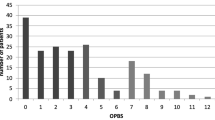Abstract
The aim of this study was to investigate whether an oral sodium phosphate solution (OSPS) mixed with aspartame-based clear liquids as the diluent would yield improved colon cleansing results compared to an OSPS mixed with sucrose-based liquids as the diluent. Fifty-one patients undergoing colonoscopy were prospectively randomized into two groups to receive different OSPS colonoscopy preparations, with sucrose-based or aspartame-based liquids used as diluents. The primary end point was the quality of the colonoscopy preparation and secondary end points were serum electrolytes before and after preparations. No significant difference in colonoscopy preparation quality was seen between the two OSPS diluent groups (Mantel-Haenzel χ 2 = 0.795, P = 0.484). There were no significant differences in mean electrolyte shifts of sodium, potassium, blood urea nitrogen (BUN), creatinine (Cr), or BUN/Cr ratios between the two groups. There was a statistically significant increase in serum phosphorous in the aspartame-based group compared to the sucrose-based diluent group (P = 0.021). In conclusion, there was no clinically detectable difference in colonoscopy preparation quality between the two OSPS diluent groups. This study suggests that passive fluid transport by aquaporins may well be the major mediator of fluid shifts in the study subjects. This result suggests the potential importance of aquaporins and minimizes the importance of sodium glucose cotransporter SGLT1 in fluid and electrolyte transport in the human gastrointestinal tract. Aspartame or its constituent amino acids may enhance phosphate absorption across the human small intestine.


Similar content being viewed by others
References
Hsu CW, Imperiale TF (1998) Meta-analysis and cost comparison of polyethylene glycol lavage versus sodium phosphate for colonoscopy preparation. Gastrointest Endosc 48:276–282
Vanner SJ, MacDonald PH, Patterson WG, Prentice RS, DaCosta LR, Beck IT (1990) A randomized prospective trial comparing oral sodium phosphate with standard polyethylene glycol based lavage solution in the preparation of patients for colonoscopy. Am J Gastroenterol 85:422–427
Kolts BE, Lyles WE, Achem SR, Burton L, Geller AJ, MacMath T (1993) A Comparison of the effectiveness and patient tolerance of oral sodium phosphate, castor oil, and standard electrolyte lavage for colonoscopy and sigmoidoscopy preparation. Am J Gastroenterol 88:1218–1223
Cohen SM, Wexner SD, Binderow SR, Nogueras JJ, Daniel N, Ehrenpreis ED, Jensen J, Bonner GF, Ruderman WB (1994) Prospective randomized, endoscopic blinded trial Comparing precolonoscopy bowel cleansing methods. Dis Colon Rectum 37:689–696
Afridi SA, Barthel HS, King PD, Pinda JJ, Marshal JB (1995) Prospective, randomized trial comparing a new sodium phosphate-bisacodyl regimen with conventional PEG-ES lavage for outpatient colonoscopy preparation. Gastrointest Endosc 4:485–489
Zeuthen T, Neuthen E, Klaerke DA (2002) Mobility of ions, sugars, and water in the cytoplasm of xenopus oocyte expressing Na(+) coupled sugar transporters (SGLT1). J Physiol 542:71–87
Diez-Sampedro A, Eskandari S, Wright EM, Hirayama BA (2001) Na(+)-to-sugar stoichiometery of SGLT3. Am J Physiol Renal Physiol 280(2):278–282
Gould GW, Holdman GD (1993) The glucose transporter family: structure, function, and tissue-specific expression. Biochem J 295:329–341
Fordtran JS (1975) Stimulation of active and passive sodium absorption by sugars in thehuman jejunum. J Clin Invest 55:728–737
Hooper NM, Hesp RJ, Tieku S (1994) Metabolism of aspartame by human and pig intestinal microvillar peptidases. Biochem J 298:635–639
Masyuk AI, Marinelli RA, LaRusso NF (2002) Water transport by epithelia of the digestive tract. Gastroenterology 122:545–562
Schultz SG (2001) Epithelial water absorption: osmosis or cotransport? Proc Natl Acad Sci 98(7):3628–3630
Aronchick CA, Lipschutz Wh, Wright SH, et al. (2000) A novel tableted purgative for colonoscopic preparation: efficacy and safety comparisons with Colyte and Fleet Phosphosoda. Gastrointest Endosc 52(3):346–352
McGee S, Abernathy WB, Simel DL (1999) The rational clinical examination. Is this patient hypovolemic? JAMA 281(11):1022–1029
Balaban DH, Leavell BS, Oblinger MJ, et al. (2003) Low volume bowel preparation for colonoscopy: randomized, endoscopist-blinded trial of liquid sodium phosphate versus tablet sodium phosphate. Am J Gastroenterol 98(4):827–832
Kim HS, Park DH, Kim JW, et al. (2005) Effectiveness of walking exercise as a bowel preparation for colonoscopy: a randomized controlled trial. Am J Gastroenterol 100:1964–1969
Ness RM, Manam R, Hoen H, et al. (2001) Predictors of inadequate bowel preparation for colonoscopy. Am J Gastroenterol 96:1797–1802
Lieberman D, Ghormley J, Flora K (1995) Effects of oral sodium phosphate colon preparation on serum electrolytes in patients with normal serum creatinine. Gastrointest Endosc 43:467–469
Ullah, N, Yeh R, Ehrinpreis M (2002) Fatal hyperphosphatemia from a phosphosoda bowel preparation. J Gastroenterol 34:457–458
Eto, N, Tomita M, Hayashi M (2006) NaPi-mediated transcellular permeation is the dominant route in intestinal inorganic phosphate absorption in rats. Drug Metab Pharmacokin 21:217–221
Larsen MJ, Nyvad B (1999) Enamel erosion by some soft drinks and orange juices relative to their pH, buffering effects, and contents of calcium phosphate. Caries Res 33:81–87
Author information
Authors and Affiliations
Corresponding author
Rights and permissions
About this article
Cite this article
Chamberlain, S.M., Balart, J.C., Sideridis, K. et al. Safety and Efficacy of Aspartame-Based Liquid Versus Sucrose-Based Liquids Used for Dilution in Oral Sodium Phosphate Solutions for Colonoscopy Preparations. Dig Dis Sci 52, 3165–3168 (2007). https://doi.org/10.1007/s10620-007-9790-8
Received:
Accepted:
Published:
Issue Date:
DOI: https://doi.org/10.1007/s10620-007-9790-8




